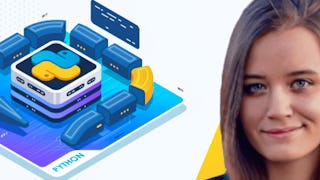Start your Python journey with this course, where you’ll gain a solid foundation in this powerful language. Learn how to work with variables and data types to store and process information, master operations to perform calculations and make comparisons, and unlock the power of strings for text manipulation. Through hands-on case studies, like creating a checkout system, splitting tips, and calculating compound interest, you’ll apply your skills to solve real-life problems. This beginner-friendly course is perfect for anyone looking to build practical coding skills and confidence in Python.

Enjoy unlimited growth with a year of Coursera Plus for $199 (regularly $399). Save now.

BiteSize Python for Absolute Beginners: Essentials
This course is part of BiteSize Python for Absolute Beginners Specialization

Instructor: Di Wu
Included with
What you'll learn
Use Python programming fundamentals, including variables, data types, and basic input/output functions
Perform arithmetic, relational, and logical operations, and manipulate strings
Analyze and create Python programs to solve real-world problems
Skills you'll gain
Details to know

Add to your LinkedIn profile
6 assignments
See how employees at top companies are mastering in-demand skills

Build your subject-matter expertise
- Learn new concepts from industry experts
- Gain a foundational understanding of a subject or tool
- Develop job-relevant skills with hands-on projects
- Earn a shareable career certificate

There are 6 modules in this course
This module introduces the basics of Python, highlighting why it is a popular programming language and how to start learning it. It covers the differences between script and interactive Python, explains why iPython is preferred, and introduces Jupyter Notebooks as a powerful tool for coding. Additionally, it explores the distinctions between local and cloud-based coding environments, including the specific setup used in Coursera labs.
What's included
11 readings1 assignment
This module explores the basics of input and output in Python. Starting with the classic "Hello, World!" example using the print() function, it explains the differences between single, double, and triple quotation marks in Python. The module also covers how to print multiple values simultaneously and introduces the input() function to receive user inputs. Learners will see how to combine input() and print() to create simple interactive programs.
What's included
1 reading1 assignment6 ungraded labs
This module introduces variables in Python, including how to define them and the rules for naming them correctly according to syntax and conventions. It covers the fundamental data types—integers (int), floating-point numbers (float), and strings (str)—and explains how to convert between these types using Python’s built-in conversion functions.
What's included
5 readings2 assignments2 ungraded labs
This module focuses on the different types of operations in Python, including assignment, arithmetic, relational, and logical operations. It explains how to use these operations to manipulate data and make comparisons within Python programs, providing a foundational understanding of how data is processed and evaluated.
What's included
1 reading1 assignment4 ungraded labs
This module delves into the str data type in Python, covering everything from the basics of what a string is to how to create, access, and manipulate strings. It includes techniques for slicing, concatenating, and formatting strings, as well as an overview of common string methods that simplify text processing tasks.
What's included
2 readings1 assignment6 ungraded labs
This module applies essential Python concepts through practical case studies, demonstrating how to solve real-life problems using the skills learned in previous modules. The case studies include a checkout system for calculating total costs, a tip-splitting application to fairly divide tips among diners, and a compound interest calculator for financial planning.
What's included
1 reading3 ungraded labs
Earn a career certificate
Add this credential to your LinkedIn profile, resume, or CV. Share it on social media and in your performance review.
Instructor

Offered by
Explore more from Data Analysis
 Status: Free Trial
Status: Free Trial Status: Free Trial
Status: Free TrialKodeKloud
 Status: Free Trial
Status: Free TrialUniversity of Colorado Boulder
 Status: Free Trial
Status: Free Trial
Why people choose Coursera for their career





Open new doors with Coursera Plus
Unlimited access to 10,000+ world-class courses, hands-on projects, and job-ready certificate programs - all included in your subscription
Advance your career with an online degree
Earn a degree from world-class universities - 100% online
Join over 3,400 global companies that choose Coursera for Business
Upskill your employees to excel in the digital economy
Frequently asked questions
To access the course materials, assignments and to earn a Certificate, you will need to purchase the Certificate experience when you enroll in a course. You can try a Free Trial instead, or apply for Financial Aid. The course may offer 'Full Course, No Certificate' instead. This option lets you see all course materials, submit required assessments, and get a final grade. This also means that you will not be able to purchase a Certificate experience.
When you enroll in the course, you get access to all of the courses in the Specialization, and you earn a certificate when you complete the work. Your electronic Certificate will be added to your Accomplishments page - from there, you can print your Certificate or add it to your LinkedIn profile.
Yes. In select learning programs, you can apply for financial aid or a scholarship if you can’t afford the enrollment fee. If fin aid or scholarship is available for your learning program selection, you’ll find a link to apply on the description page.
More questions
Financial aid available,

